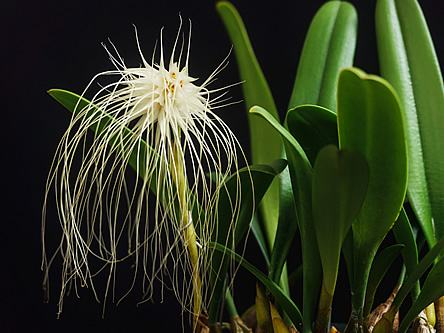The Medusa Orchid (Bulbophyllum medusae) is a flowering species, epiphytic in nature, with sympodial growth, originating from lowland forests near sea level in Thailand, Borneo, the Philippines, the Sunda Islands, and Sumatra. It is known and appreciated by orchid enthusiasts and collectors worldwide for the curious appearance of its inflorescences, which resemble the legendary Medusa from Greek mythology.
It features small pseudobulbs, about 1.18 inches (3 centimeters) in length, rounded, each with a single erect, dark green leaf measuring 3.15 inches (8 centimeters). The strong rhizome is ascending and climbing. Inflorescences emerge at the base of new pseudobulbs in the autumn, rising slightly above the foliage. Each inflorescence is a cluster with 30 to 100 small cream-colored, almost white, densely packed flowers, each with long, filamentous sepals that give the species its characteristic appearance. It is said that the flowers are fragrant, but with an unpleasant odor for many people.
This beautiful and exotic orchid thrives in wide and shallow pots, as well as in hanging baskets, allowing the clump to acquire a rounded appearance, spreading throughout the container so that its flowers can be fully appreciated by onlookers. In the garden, it can also be cultivated by tying it to tree trunks, provided they are not shedding their bark. The Medusa Orchid is typically a tropical plant and appreciates warm, humid, yet well-ventilated locations.
The Medusa Orchid should be grown in partial shade or filtered light, in a lightweight, well-draining substrate suitable for epiphytic plants, and watered regularly. The substrate can include dry branches, coconut fiber, stones, coconut or pine bark, sphagnum moss, etc. When choosing the ideal shade cloth for this species, prefer those with shading rates of 50 to 60%.
Fertilize with orchid-specific fertilizers and bokashi. Slightly reduce watering when the flowering begins. The Bulbophyllum medusae orchid can be propagated by dividing the clumps, with each new plant having at least three pseudobulbs connected by the rhizome and a shoot. Attempting propagation with fewer pseudobulbs has a high chance of causing the plant’s death or significantly delaying its development. Commercial orchid nurseries propagate the species through seeds and meristem culture in laboratories.

